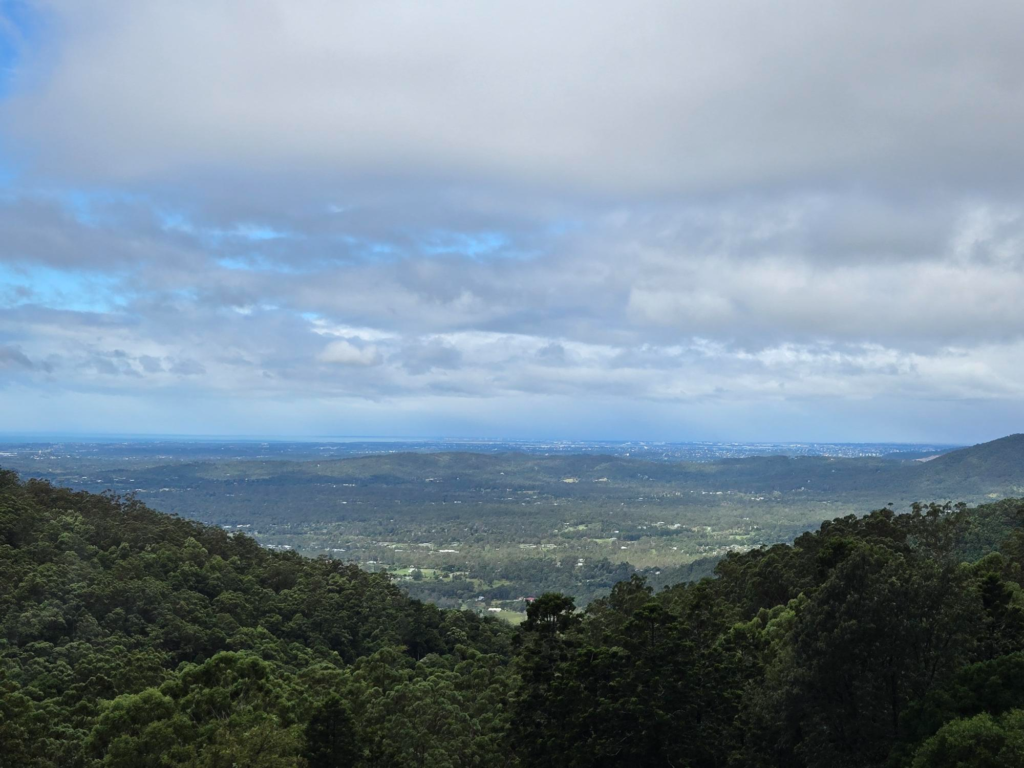
As Tropical Cyclone Alfred bears down on South East Queensland on 7 March 2025, a Category 1 to 2 storm with winds peaking at 130 km/h, the region has been brought to a standstill. Schools are closed, public transport is halted, businesses are shuttered, and elective surgeries are cancelled, all at an estimated cost of billions of dollars to the Queensland economy. In a state well accustomed to fierce storms and seasonal flooding, this response prompts a critical question: is this a justified precaution, or a costly overreach driven by political opportunism with an election on the horizon?
Sensationalist Reporting: A Photo That Tells All

A photo taken at 2pm on 7 March 2025, capturing the view from around 40kms west of Brisbane city looking out to Moreton Bay and the Pacific Ocean, where the Cyclone is supposed to be, reveals a striking truth: no inclement weather—just clear skies and calm conditions inland, just hours before Cyclone Alfred’s claimed landfall. This image stands in sharp contrast to the sensationalist reporting that’s gripped South East Queensland, where government warnings of “life-threatening” chaos and media headlines of impending doom have justified a billion-dollar shutdown. If a 40-kilometer stretch of the region’s heartland looks this tranquil mid-crisis, why the all-out panic? This isn’t just a snapshot; it’s a rebuke to the hype that’s cost Queenslanders dearly, exposing a narrative that’s outrun reality.
A Familiar Challenge, an Excessive Reaction
South East Queensland, encompassing Brisbane and its 2.5 million residents, faces turbulent weather annually. Heavy rainfall, hail, and flash flooding are regular occurrences, disrupting daily life but rarely grinding it to a complete halt. Cyclone Alfred, expected to cross the coast between Coolangatta and Maroochydore on Friday afternoon, is noteworthy but far from extraordinary. The Bureau of Meteorology predicts sustained winds of up to 120 km/h, a storm surge lifting tides by half a metre, and rainfall that could reach 700 mm in isolated areas over three days. By Friday evening, the cyclone is forecast to weaken into a tropical low—a significant but manageable event for a state known for its resilience.
Yet, the government’s response paints a picture of imminent catastrophe. Queensland Premier David Crisafulli has issued dire warnings of widespread flooding and distributed 250,000 sandbags, while Prime Minister Anthony Albanese has deployed the Australian Defence Force. Brisbane Lord Mayor Adrian Schrinner has suggested 20,000 properties could be “impacted,” a term vague enough to cover anything from minor inundation to structural damage. This blanket shutdown of a major economic hub is unprecedented for a storm of this magnitude, contrasting sharply with the practical approach taken in northern Queensland, where Category 2 cyclones are weathered without such drastic measures.
The Soaring Cost of Overcaution
The financial burden of this decision is immense. Shutting down South East Queensland, the economic engine of the state, disrupts supply chains, stalls retail, and cripples services. Early estimates suggest the cost could reach upwards of $2 billion AUD—approaching the $4 billion price tag of the 2022 floods, a far more severe disaster. Factor in the deployment of 1,000 Ergon Energy crews, military personnel, and extensive preparatory efforts, and this becomes a glaring example of government extravagance. For Queensland taxpayers, this is not just an inconvenience; it is a direct drain on public funds at a time when fiscal restraint should be a priority.
The social toll is equally significant. Families are disrupted, workers lose income, and vulnerable communities are left grappling with a fear-laden narrative. With an election looming, such high-profile action might bolster the government’s image as resolute, but it risks alienating voters who see it as wasteful grandstanding.
Political Gamesmanship at Play
What drives this disproportionate response? The answer lies in the political calendar. With an election approaching, both state and federal leaders face pressure to appear decisive in tackling “extreme weather”—a phrase that resonates with voters concerned about climate change. Cyclone Alfred, the first to hit Brisbane since 1974, provides a rare chance to showcase authority, even if its strength does not justify such measures. The government’s rhetoric—peppered with terms like “life-threatening” and “destructive”—is echoed by a compliant legacy media, churning out alarming headlines to keep the public on edge.
This is not to dismiss the risks entirely. Low-lying areas such as Nudgee Beach and Pelican Waters face genuine threats, and residents must take sensible precautions. But closing an entire region, rather than targeting resources to vulnerable zones, reeks of political theatre. Climate change, a perennial election issue, offers a convenient backdrop. By casting Alfred as a symptom of worsening weather—despite evidence that tropical cyclones are not becoming more frequent, only shifting south—leaders can position themselves as proactive guardians of a warming planet, deflecting scrutiny from their spending.
A Demand for Accountability
The government’s role is to protect, not paralyse. Northern Queensland’s pragmatic response to similar storms—securing properties, clearing drains, and keeping essential services running—offers a blueprint that balances safety with common sense. South East Queensland deserves no less, not a knee-jerk lockdown that siphons billions from the treasury and stokes public anxiety for political gain.
As Cyclone Alfred passes, the real reckoning will not come from the weather, but from the electorate. Voters, already strained by rising costs and economic uncertainty, may not forgive this mix of waste and manipulation. With billions spent and an election nearing, the government must explain: was this about safeguarding Queensland, or shoring up votes? The taxpayers of South East Queensland deserve answers—and their money’s worth.
